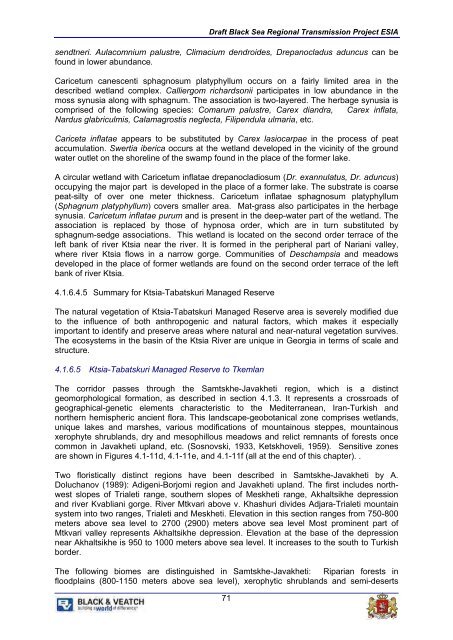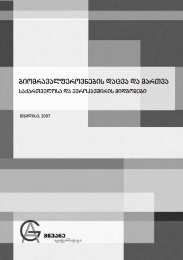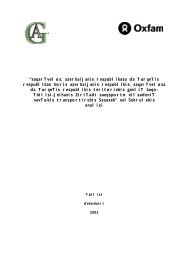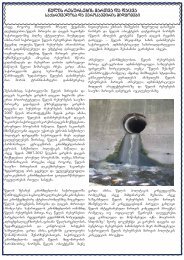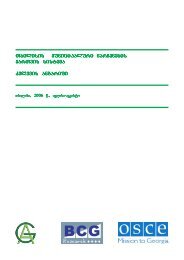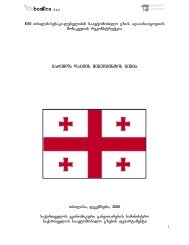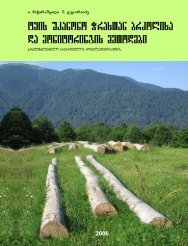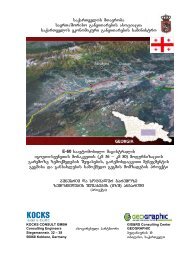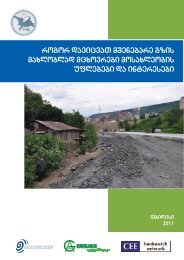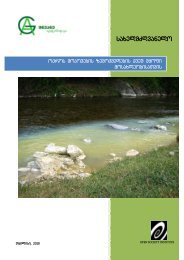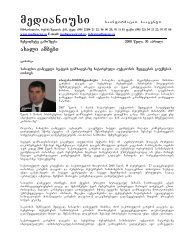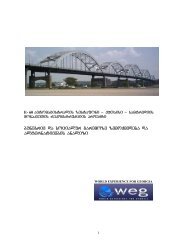Part I
Part I
Part I
Create successful ePaper yourself
Turn your PDF publications into a flip-book with our unique Google optimized e-Paper software.
Draft Black Sea Regional Transmission Project ESIA<br />
sendtneri. Aulacomnium palustre, Climacium dendroides, Drepanocladus aduncus can be<br />
found in lower abundance.<br />
Caricetum canescenti sphagnosum platyphyllum occurs on a fairly limited area in the<br />
described wetland complex. Calliergom richardsonii participates in low abundance in the<br />
moss synusia along with sphagnum. The association is two-layered. The herbage synusia is<br />
comprised of the following species: Comarum palustre, Carex diandra, Carex inflata,<br />
Nardus glabriculmis, Calamagrostis neglecta, Filipendula ulmaria, etc.<br />
Cariceta inflatae appears to be substituted by Carex lasiocarpae in the process of peat<br />
accumulation. Swertia iberica occurs at the wetland developed in the vicinity of the ground<br />
water outlet on the shoreline of the swamp found in the place of the former lake.<br />
A circular wetland with Caricetum inflatae drepanocladiosum (Dr. exannulatus, Dr. aduncus)<br />
occupying the major part is developed in the place of a former lake. The substrate is coarse<br />
peat-silty of over one meter thickness. Caricetum inflatae sphagnosum platyphyllum<br />
(Sphagnum platyphyllum) covers smaller area. Mat-grass also participates in the herbage<br />
synusia. Caricetum inflatae purum and is present in the deep-water part of the wetland. The<br />
association is replaced by those of hypnosa order, which are in turn substituted by<br />
sphagnum-sedge associations. This wetland is located on the second order terrace of the<br />
left bank of river Ktsia near the river. It is formed in the peripheral part of Nariani valley,<br />
where river Ktsia flows in a narrow gorge. Communities of Deschampsia and meadows<br />
developed in the place of former wetlands are found on the second order terrace of the left<br />
bank of river Ktsia.<br />
4.1.6.4.5 Summary for Ktsia-Tabatskuri Managed Reserve<br />
The natural vegetation of Ktsia-Tabatskuri Managed Reserve area is severely modified due<br />
to the influence of both anthropogenic and natural factors, which makes it especially<br />
important to identify and preserve areas where natural and near-natural vegetation survives.<br />
The ecosystems in the basin of the Ktsia River are unique in Georgia in terms of scale and<br />
structure.<br />
4.1.6.5 Ktsia-Tabatskuri Managed Reserve to Tkemlan<br />
The corridor passes through the Samtskhe-Javakheti region, which is a distinct<br />
geomorphological formation, as described in section 4.1.3. It represents a crossroads of<br />
geographical-genetic elements characteristic to the Mediterranean, Iran-Turkish and<br />
northern hemispheric ancient flora. This landscape-geobotanical zone comprises wetlands,<br />
unique lakes and marshes, various modifications of mountainous steppes, mountainous<br />
xerophyte shrublands, dry and mesophillous meadows and relict remnants of forests once<br />
common in Javakheti upland, etc. (Sosnovski, 1933, Ketskhoveli, 1959). Sensitive zones<br />
are shown in Figures 4.1-11d, 4.1-11e, and 4.1-11f (all at the end of this chapter). .<br />
Two floristically distinct regions have been described in Samtskhe-Javakheti by A.<br />
Doluchanov (1989): Adigeni-Borjomi region and Javakheti upland. The first includes northwest<br />
slopes of Trialeti range, southern slopes of Meskheti range, Akhaltsikhe depression<br />
and river Kvabliani gorge. River Mtkvari above v. Khashuri divides Adjara-Trialeti mountain<br />
system into two ranges, Trialeti and Meskheti. Elevation in this section ranges from 750-800<br />
meters above sea level to 2700 (2900) meters above sea level Most prominent part of<br />
Mtkvari valley represents Akhaltsikhe depression. Elevation at the base of the depression<br />
near Akhaltsikhe is 950 to 1000 meters above sea level. It increases to the south to Turkish<br />
border.<br />
The following biomes are distinguished in Samtskhe-Javakheti: Riparian forests in<br />
floodplains (800-1150 meters above sea level), xerophytic shrublands and semi-deserts<br />
71


